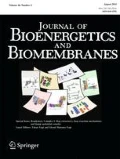Abstract
The present investigation identifies the molecular basis for the well-documented inhibition of the mitochondrial inner membrane citrate transport protein (CTP) function by the lysine-selective reagent pyridoxal 5′-phosphate. Kinetic analysis indicates that PLP is a linear mixed inhibitor of the Cys-less CTP, with a predominantly competitive component. We have previously concluded that the CTP contains at least two substrate binding sites which are located at increasing depths within the substrate translocation pathway and which contain key lysine residues. In the present investigation, the roles of Lys-83 in substrate binding site one, Lys-37 and Lys-239 in substrate binding site two, and four other off-pathway lysines in conferring PLP-inhibition of transport was determined by functional characterization of seven lysine to cysteine substitution mutants. We observed that replacement of Lys-83 with cysteine resulted in a 78% loss of the PLP-mediated inhibition of CTP function. In contrast, replacement of either Lys-37 or Lys-239 with cysteine caused a modest reduction in the inhibition caused by PLP (i.e., 31% and 20% loss of inhibition, respectively). Interestingly, these losses of PLP-mediated inhibition could be rescued by covalent modification of each cysteine with MTSEA, a reagent that adds a lysine-like moiety (i.e. SCH2CH2NH3 +) to the cysteine sulfhydryl group. Importantly, the replacement of non-binding site lysines (i.e., Lys-45, Lys-48, Lys-134, Lys-141) with cysteine resulted in little change in the PLP inhibition. Based upon these results, we conducted docking calculations with the CTP structural model leading to the development of a physical binding model for PLP. In combination, our data support the conclusion that PLP exerts its main inhibitory effect by binding to residues located within the two substrate binding sites of the CTP, with Lys-83 being the primary determinant of the total PLP effect since the replacement of this single lysine abolishes nearly all of the observed inhibition by PLP.
Similar content being viewed by others
References
Brunengraber H, Lowenstein JM (1973) FEBS Lett 36:130–132
Conover TE (1987) Trends Biochem Sci 12:88–89
Cornish-Bowden A (1974) Biochem J 137:143–144
Cortes A, Cascante M, Cardenas ML, Cornish-Bowden A (2001) Biochem J 357:263–268
Dierks T, Stappen R, Salentin A, Kramer R (1992) Biochim Biophys Acta 1103:13–24
Endemann G, Goetz PG, Edmond J, Brunengraber H (1982) J Biol Chem 257:3434–3440
Gremse DA, Dean B, Kaplan RS (1995) Arch Biochem Biophys 316:215–219
Halgren TA (1999) J Comput Chem 20:616–641
Kaplan RS, Pedersen PL (1985) Anal Biochem 150:97–104
Kaplan RS, Morris HP, Coleman PS (1982) Cancer Res 42:4399–4407
Kaplan RS, Mayor JA, Johnston N, Oliveira DL (1990a) J Biol Chem 265:13379–13385
Kaplan RS, Oliveira DL, Wilson GL (1990b) Arch Biochem Biophys 280:181–191
Kaplan RS, Mayor JA, Wood DO (1993) J Biol Chem 268:13682–13690
Kaplan RS, Mayor JA, Gremse DA, Wood DO (1995) J Biol Chem 270:4108–4114
Kaplan RS, Mayor JA, Brauer D, Kotaria R, Walters DE, Dean AM (2000) J Biol Chem 275:12009–12016
Lundblad RL (1991) Chemical reagents for Protein modification. CRC Press, Boca Raton, FL
Ma C, Kotaria R, Mayor JA, Eriks LR, Dean AM, Walters DE, Kaplan RS (2004) J Biol Chem 279:1533–1540
Ma C, Kotaria R, Mayor JA, Remani S, Walters DE, Kaplan RS (2005) J Biol Chem 280:2331–2340
Ma C, Remani S, Sun J, Kotaria R, Mayor JA, Walters DE, Kaplan RS (2007) J Biol Chem 282:17210–17220
Mannella CA (1997) J Bioenerg Biomembr 29:525–531
Palmieri F, Stipani I, Quagliariello E, Klingenberg M (1972) Eur J Biochem 26:587–594
Palmieri L, Lasorsa FM, De-Palma A, Palmieri F, Runswick MJ, Walker JE (1997a) FEBS Lett 417:114–118
Palmieri L, Marco VD, Iacobazzi V, Palmieri F, Runswick MJ, Walker JE (1997b) FEBS Lett 410:447–451
Palmieri L, Agrimi G, Runswick MJ, Fearnley IM, Palmieri F, Walker JE (2001) J Biol Chem 276:1916–1922
Rippa M, Spanio L, Pontremoli S (1967) Arch Biochem Biophys 118:48–57
Robinson AJ, Kunji ERS (2006) Proc Nat Acad Sci USA 103:2617–2622
Todisco S, Agrimi G, Castegna A, Palmieri F (2006) J Biol Chem 281:1524–1531
Walters DE, Kaplan RS (2004) Biophys J 87:907–911
Watson JA, Lowenstein JM (1970) J Biol Chem 245:5993–6002
Xu Y, Mayor JA, Gremse D, Wood DO, Kaplan RS (1995) Biochem Biophys Res Commun 207:783–789
Xu Y, Kakhniashvili DA, Gremse DA, Wood DO, Mayor JA, Walters DE, Kaplan RS (2000) J Biol Chem 275:7117–7124
Author information
Authors and Affiliations
Corresponding author
Additional information
This work was supported by National Institutes of Health Grant GM-054642 to R.S.K.
Rights and permissions
About this article
Cite this article
Remani, S., Sun, J., Kotaria, R. et al. The yeast mitochondrial citrate transport protein: identification of the Lysine residues responsible for inhibition mediated by Pyridoxal 5′-phosphate. J Bioenerg Biomembr 40, 577–585 (2008). https://doi.org/10.1007/s10863-008-9187-1
Received:
Accepted:
Published:
Issue Date:
DOI: https://doi.org/10.1007/s10863-008-9187-1




